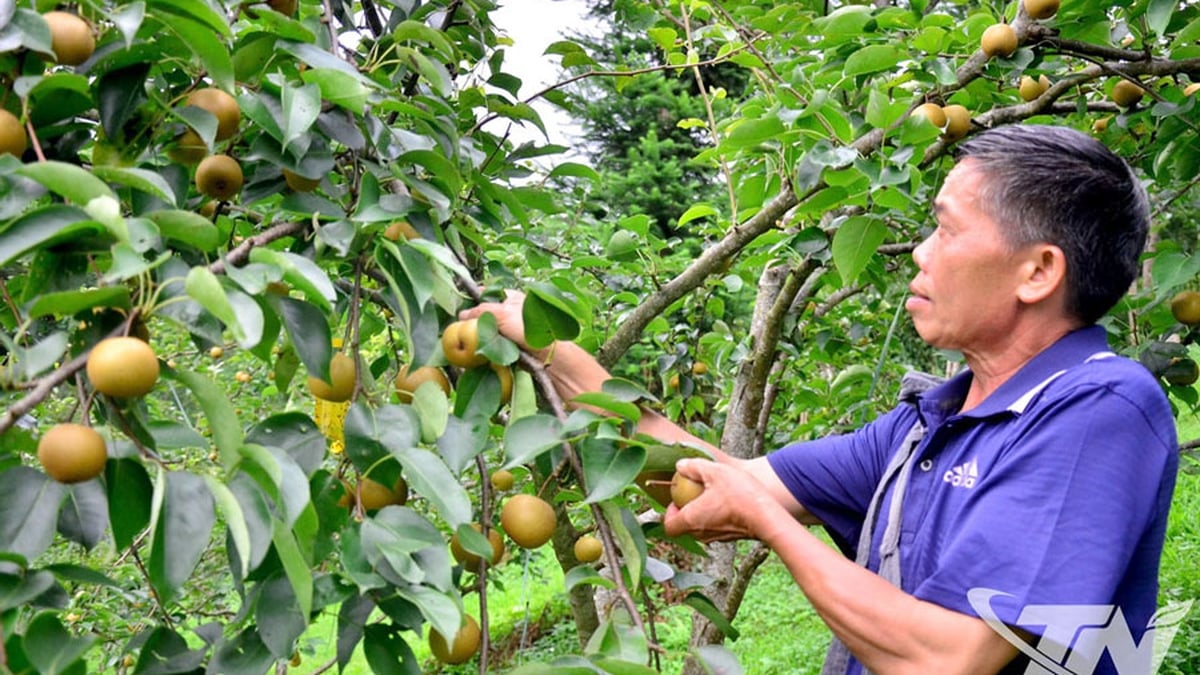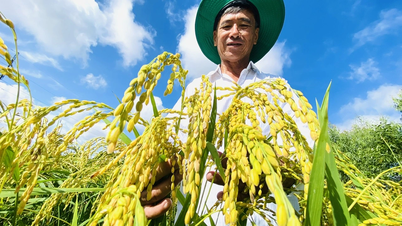"The worst single ever"

On weekends, Vinh market only has a few customers, mainly wholesalers. The stalls are deserted, some kiosk owners are embroidering, others are surfing their phones, and some are playing cards to kill time. Ms. Nguyen Hai Tan, owner of a shoe kiosk, said: “It’s very quiet. There are no people coming and going at the market, and there are few buyers. Every year, at this time of the year, shoes sell well. But this year, there are backlogs and sales are sluggish.”
On the second floor, clothing kiosks are also full of winter clothes such as down jackets, sweatshirts, wool coats, sweaters... but are also very quiet. Having been in the clothing business at Vinh market for more than 30 years, Mr. Pham The Chien said that the sluggish situation has lasted for 5-7 years. However, from 2020 to now is the peak. In particular, in 2023, the sluggish situation is considered "unprecedented" by traders.

“For the past three years, especially after the Covid-19 pandemic, customers have been absent. However, we still have to import goods, update fashion trends, and diversify designs to serve customers. Along with that, we accept to sell at a discount, some items are only sold at break-even, even at a loss to attract customers, but it still doesn't work. Compared to before, the number of retail customers has decreased by 80%, now we only maintain wholesale customers. Before 2020, the 2 kiosks employed 4 employees, but in the past 2 years, to reduce costs, we have cut them all, leaving only the couple standing at the booth,” said Mr. Chien.
Not only are clothing and jewelry stalls deserted, but household goods stalls are also often in a situation where there are more sellers than buyers. At Vinh train station market, Quan Lau market, Hung Dung market, in addition to the fresh food stalls that are bustling with buyers and sellers, the main hall is deserted and quiet. Many stalls have signs for transfer, sublease, and sale of stalls. Small traders try to stick with their daily business by opening stalls to sell, but there are no buyers. Some kiosks do not sell any items all day.

Mr. Le Van Thanh, Hung Dung Market Management Board said: "Many traders who are selling fashion, cosmetics, and footwear at the market said that the number of customers coming to buy and sell is decreasing, and the circulation of goods is much slower than in the previous period."
Not only in the city, but also in the central markets of rural areas, business is sluggish, there are no buyers, and the circulation of goods has decreased. Famous markets such as Sa Nam (Nam Dan), Giat (Quynh Luu), Sy (Dien Chau)… which used to be bustling, bustling with business and trading, are now also deserted, with the number of customers decreasing by 50-60% compared to before.
“All items in the market are sluggish. From essential food to clothing and footwear. No matter how difficult it is, we still have to buy rice, buy food, buy daily necessities, right? Therefore, saying it is due to economic difficulties is only a part of it,” said a trader.
According to statistics from the Department of Industry and Trade of Nghe An , currently, the whole province has 371 traditional markets in operation, including 7 class I markets, 20 class II markets, 240 class III markets and 104 unclassified markets. Of which, more than 70% are built solidly or semi-solidly; temporary markets are also upgraded and repaired by localities to meet the business needs of small traders and people's consumption. However, with the explosion of technology and modern business models, a part of the people have changed, approaching new consumption habits, causing traditional markets to face many difficulties and are at risk of losing their position.
Online shopping "reigns"

Along with the economic difficulties, people cut spending, limit shopping, so purchasing power in the market decreased, supermarkets and convenience stores sprung up everywhere, making traditional markets no longer have much "room to live". However, the main reason is still the change in consumption trends, people switch from direct shopping to online, instead of going to the market, they go to e-commerce sites, online markets to buy goods.
Ms. Duong Thi Nga - owner of a bookstore in Hung Dung ward (Vinh city), said: "Before, I went to the market every day, but for about 5 years now, I only occasionally stop by to buy vegetables when I need them suddenly, and everything else is bought online. When I open Facebook, everything is available, the prices are clearly listed, I can see the goods, and only pay when I am satisfied, so now, all my clothes, shoes, household items and even fresh food are bought online."

As social networks and the internet become popular, the formation of residential market groups and community groups also develops, thereby promoting more convenient electronic goods shopping. Currently, 100% of wards and communes in Vinh city have market groups such as: Hung Dung fresh food market, Coi market, Nghi Phu market... items from bunches of vegetables to fish are posted, orders are received, and goods are shipped.
Ms. Nguyen Thi Mui, who sells fresh food products at an apartment complex in Quan Bau ward, shared: "I specialize in transporting food from the countryside such as meat, fish, vegetables and fruits to sell to groups of residents. Most of the residents participate in this group, so the number of customers is very large. I base on the pre-orders of customers to pick up and ship the goods."

With the advantage of not wasting time traveling, not wasting effort choosing, bargaining, just one operation on the phone, consumers can "buy the whole world". Besides, with advantages such as no cost of premises, no cost of hiring employees, the prices of online items are also cheaper, accompanied by promotional and discount policies. Not only that, this type also has a customer care policy and brings a new, strange shopping experience, so it is very popular with consumers, especially young people. Therefore, online shopping has become a habit, an inevitable trend in the 4.0 era.
Ms. Nguyen Thu Huong, an office worker in Vinh city, said: “I only go to the market or supermarket 1-2 times a month to shop. Mainly to go out to visit and relax. Everything needed for daily life from food, clothing to medicine is bought online. Buying in combos or orders with a value of 300,000 VND or more is free shipping. Compared to the time I have to travel, go to the market to choose, pay for gas, and pay for parking, the inner-city shipping fee of 10,000-15,000 VND/order is still more profitable, without wasting time, effort, no crowds, no dust.”

According to statistics, domestic e-commerce sales in the third quarter of this year increased by about 40% compared to the same period last year, and this growth rate remains at a good level of 25 - 40% per year. The growth of e-commerce and the decline in traditional retail channels are inevitable and in line with the development trend.
Change to adapt

Faced with that social trend, with the competition of modern business models and online trading to revive the position of traditional markets, many localities have attracted investment, transformed market management models, contributed to building spacious and modern markets; made efforts to eliminate temporary markets so that traditional markets can become trading and buying and selling points for people.
At the same time, localities have coordinated with market management boards to annually organize training courses, equipping traders with sales skills, encouraging traders to change their behavior, and build a civilized and polite business culture. At the same time, sell products with clear origin and source, at the correct listed price; pay attention to how to display goods to make them beautiful and convenient, and open more utilities such as home delivery, good after-sales policies... to meet the increasing needs of consumers.

In particular, with the trend of online shopping on the rise, small traders must also approach this sales channel, maintaining both direct and online sales. Ms. Le Giang, owner of a clothing kiosk in Vinh market, said: "Every day, I display products at the kiosk, both to welcome retail and wholesale customers and livestream to sell to customers everywhere. At the same time, I proactively promote product advertising through social networking platforms such as Facebook and Zalo."
According to Ms. Le Giang, at first, selling online was not easy, from learning how to speak, how to introduce, how to interact with customers, not attracting a large number of followers. After that, she sold on many websites by continuously posting clothing models, livestreaming... so the number of followers increased, helping the products to be sold in larger quantities.

The same goes for fresh food products. Many retailers have known how to combine direct and online sales. Every morning, when she goes to the wharf to get fish, Ms. Nguyen Thi Giang (Nghi Hai, Cua Lo Town) does not forget to livestream images of fishermen removing nets, fresh fish, transportation... And when she goes to Quan Lau market (Vinh City), she also prepares goods and introduces to customers online the types of fish she has today, how fresh they are, and what the prices are...
“Customers look at the images I film, take and choose. Then, my husband will ship the goods to the customer's requested location. My customers are mainly office workers in Vinh city. Although I rent a space in the market, the amount of goods sold mainly to online customers accounts for 70%; only about 30% are sold directly,” said Ms. Giang.

Reality has proven that digital technology has brought sellers and buyers closer together, in the most convenient way possible. This is an inevitable trend that forces traditional businesses to transform to adapt to reality…
In recent years, the industry and trade sector has had many solutions as well as developed plans to re-plan traditional markets and upgrade infrastructure to better meet the civilized and modern consumption needs of the people. At the same time, it has focused on propaganda, guidance, and support for small traders to promote commercial services on digital platforms and e-commerce transactions to revive businesses. Currently, many small traders in the market maintain traditional sales while livestreaming online sales; proactively promoting product advertising through social networking platforms such as Facebook and Zalo. This is an inevitable transformation and change...
Source
























![[Photo] National Assembly Chairman Tran Thanh Man visits Vietnamese Heroic Mother Ta Thi Tran](https://vphoto.vietnam.vn/thumb/1200x675/vietnam/resource/IMAGE/2025/7/20/765c0bd057dd44ad83ab89fe0255b783)










































































Comment (0)